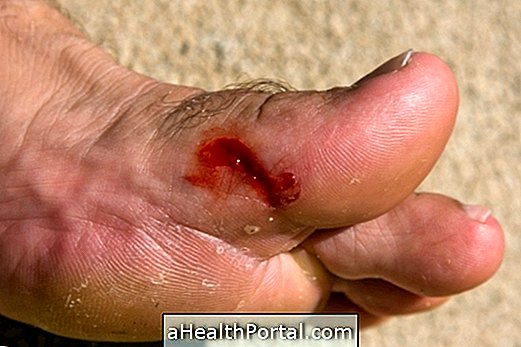Pyelonephritis is a urinary tract infection, usually caused by bacteria coming from the bladder, which strikes the kidneys causing inflammation. These bacteria are normally present in the gut, but due to some condition they can proliferate and reach the kidneys.
This inflammation is more common in infants less than one year old, women, because of the greater proximity between the anus and the urethra, and in men with benign prostatic hyperplasia, as there is an increase in urinary retention.
Pyelonephritis can be classified as:
- Acute pyelonephritis, when the infection arises suddenly and intensely, disappearing after a few weeks or days;
- Chronic pyelonephritis, which is characterized by recurrent bacterial infections and which have not been well cured, causing prolonged inflammation in the kidney and serious injuries that can lead to kidney failure.

Main symptoms
The most characteristic symptoms of pyelonephritis are pain in the lumbar and renal colic. Other symptoms are:
- Pain and burning on urination;
- Constant urge to urinate;
- Urine with bad smell;
- Fever;
- Nausea;
- Urine blurred.
In addition, in the urine examination are indicated the presence of numerous bacteria and leukocytes in addition to the presence of blood in some cases. See what the symptoms of urinary tract infection are.
In addition to the acute and chronic forms, pyelonephritis may be termed emphysematous or xanthogranulomatous according to the symptoms that arise. In emphysematous pyelonephritis there is accumulation of gases produced by the bacteria present in the kidney, being more common in diabetics, whereas xanthogranulomatous pyelonephritis is characterized by intense and constant inflammation of the kidney, which leads to its destruction.
Pyelonephritis in pregnancy
Pyelonephritis in pregnancy is usually due to a prolonged infection in the bladder, usually caused by bacteria or fungi such as Candida albicans .
In pregnancy, kidney infections are quite common because increasing levels of hormones such as progesterone leads to relaxation of the urinary tract, facilitating the entry of bacteria into the bladder and its multiplication. When the infection is not diagnosed or treated, the microorganisms multiply and begin to rise in the urinary tract, reaching the kidneys and causing their inflammation.
Treatment of pyelonephritis in pregnancy can be done with antibiotics, such as amoxicillin, which have no effect on the development of the baby.
How is the treatment done?
Treatment of pyelonephritis is usually done with antibiotics such as amoxicillin or ciprofloxacin and should begin as soon as possible to prevent damage to the kidneys and prevent bacteria from spreading into the bloodstream causing septicemia. Analgesics and anti-inflammatories can be used to relieve pain.
When pyelonephritis is caused by obstruction or malformation of the kidney, surgery may be needed to correct the problem.
Acute pyelonephritis, when untreated, may favor the occurrence of septicemia, renal abscess, renal failure, hypertension, and chronic pyelonephritis. In case of chronic pyelonephritis, severe kidney damage and kidney failure, in addition to the use of antibiotics, it may be necessary to have dialysis every week to filter the blood.
How is the diagnosis made?
The diagnosis of pyelonephritis is made by the urologist through evaluation of the patient's symptoms, physical examination such as palpation of the lumbar region and examination of urine to identify the presence of blood, leukocytes and bacteria in the urine. Ultrasound, x-ray, and computed tomography can be performed to confirm the diagnosis.
The uroculture and antibiogram may also be requested by the physician in order to identify the causative agent of pyelonephritis and establish the best line of treatment. Understand how the uroculture is made.
Pyelonephritis can be confused with urethritis and cystitis, since they are all urinary tract infections. However, pyelonephritis corresponds to infection that reaches the kidneys, whereas in cystitis the bacteria reach the bladder and in urethritis, the urethra. Learn what urethritis is and how to treat it.





















